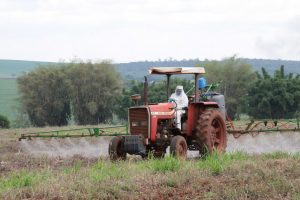07
Nov
Brazilian Researchers Link Rise in Colon Cancer to Increase in Pesticide Use
 (Beyond Pesticides, November 7, 2018) Brazil’s rapid industrialization of its agricultural sector may be coming at the cost of resident health, according to a new study published in Chemosphere by an international team of scientists. The researchers link the rise in the country’s pesticide use since the turn of the century to significant increases in colon cancer, particularly in the country’s most intensive agricultural southern regions. With the recent election of far right president Jair Bolsonaro, who has supported policies that would loosen Brazil’s pesticide regulations, advocates are concerned the county’s farming industry is moving in an unsustainable direction.
(Beyond Pesticides, November 7, 2018) Brazil’s rapid industrialization of its agricultural sector may be coming at the cost of resident health, according to a new study published in Chemosphere by an international team of scientists. The researchers link the rise in the country’s pesticide use since the turn of the century to significant increases in colon cancer, particularly in the country’s most intensive agricultural southern regions. With the recent election of far right president Jair Bolsonaro, who has supported policies that would loosen Brazil’s pesticide regulations, advocates are concerned the county’s farming industry is moving in an unsustainable direction.
Researchers note that as Brazil’s agriculture industry has grown over the last two decades, it has become the world’s leading consumer of pesticides. In the year 2000, roughly 160 million tons of pesticides were used in the country. By 2012, that number reached nearly 500 million tons. Scientists compared pesticides sold to standard mortality rates (SMR) in each Brazilian state. SMR measures mortality by comparing observed mortality to expected mortality when adjusting for age and gender. A rate above one indicates that there is excessive mortality.
Despite improvements in detection and treatment, colon cancer deaths recorded in the country increased from roughly 950k in 2000 to over one million by 2012. Using a series of statistical models, researchers showed that as the amount of pesticide sold in the country increased, the SMR for colon cancer increased in close correlation. This trend held for both male and female populations.
“The results show a strong link [between pesticides and colon cancer mortality] and as such cannot be ignored,” said study co-author Francis Martin, PhD, of the University of Central Lancashire’s School of Pharmacy and Biomedical Sciences in the United Kingdom to SciDevNet. “It is now critical to determine whether [exposure to pesticides] has the potential to turn normal cells into cancer cells by acting as endocrine disruptors or by damaging DNA.”
Beyond Pesticides’ Pesticide Induced Diseases Database lists a number studies linking agricultural pesticide use to colon cancer. Much of this research focuses on the risk to farmers and applicators, but residents can also be exposed to pesticides through drift, runoff into drinking water sources, and residues on food. Authors of the study are concerned with Brazilian government data showing that 20% of food sampled between 2013 and 2015 was considered unsafe due to high pesticide residue.
Researchers made the following findings using U.S. data in Pesticide use and colorectal cancer risk in the Agricultural Health Study:
“We investigated the relationship between agricultural pesticides and colorectal cancer incidence in the Agricultural Health Study. A total of 56,813 pesticide applicators with no prior history of colorectal cancer were included in this analysis. Detailed pesticide exposure and other information were obtained from self-administered questionnaires completed at the time of enrollment (1993-1997). Cancer incidence was determined through population-based cancer registries from enrollment through December 31, 2002. A total of 305 incident colorectal cancers (212 colon, 93 rectum) were diagnosed during the study period, 1993-2002. Although most of the 50 pesticides studied were not associated with colorectal cancer risk, chlorpyrifos use showed significant exposure response trend (p for trend = 0.008) for rectal cancer, rising to a 2.7-fold (95% confidence interval: 1.2-6.4) increased risk in the highest exposure category. Aldicarb was associated with a significantly increased risk of colon cancer (p for trend = 0.001), based on a small number of exposed cases, with the highest exposure category resulting in a 4.1-fold increased risk (95% confidence interval: 1.3-12.8).”
Researchers indicate that their data reveal pesticide exposure to be a potential risk factor for colon cancer, and indicate their correlational findings warrant further investigation. As a result of increasing attention to pesticide dangers, earlier this year a Brazilian judge ordered a suspension of glyphosate, the most widely used herbicide in the world. Reports from other South American countries such as Argentina indicate that there is widespread poisoning arising from the increasing use of genetically engineered crops developed to tolerate repeated sprayings of glyphosate and other pesticides.
As evidence continues to accumulate on the dangers of increasing pesticide use, developing countries still have an opportunity to shift to safer, sustainable organic farming practices. For more information on why organic is the right choice for the future of farming, see Beyond Pesticides’ organic program page. And for more information on the dangers of pesticide exposure, see resources on the Safer Choice webpage.
All unattributed positions and opinions in this piece are those of Beyond Pesticides.
Source: SciDevNet, Chemosphere










